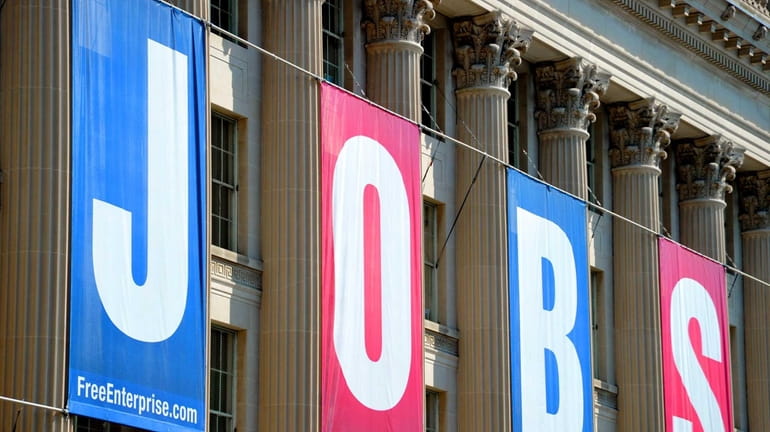U.S. economy adds 157,000 jobs in January, jobless rate at 7.9%

Payrolls rose 157,000 after a revised 196,000 advance in the prior month and a 247,000 surge in November, Labor Department figures released Feb. 1, 2013, showed in Washington. (Sept. 2, 2010) Credit: AFP/Getty Images
Hiring increased in January after accelerating more than previously estimated at the end 2012, evidence the U.S. labor market was making progress even as lawmakers quarreled over the federal budget.
Payrolls rose 157,000 following a revised 196,000 advance in the prior month and a 247,000 surge in November, Labor Department figures showed in Washington. The revisions added a total of 127,000 jobs to the employment count in November and December. The jobless rate increased to 7.9 percent from 7.8 percent.
Sustained hiring gains will give incomes a lift, buffering American workers from the sting of higher payroll taxes and helping them keep spending. At the same time, bigger employment advances are needed to drive down a jobless rate that Federal Reserve officials say is too high.
"Improvement in the labor market is continuing," Jonathan Basile, a U.S. economist at Credit Suisse in New York, said before the report. "Even though there were concerns about the fiscal cliff, it looks like they did not show up in hiring decisions." The median forecast of 90 economists surveyed by Bloomberg called for an advance of 165,000 in January payrolls. Projections ranged from gains of 115,000 to 230,000 following an initially reported 155,000 increase in December.
The Labor Department today also issued its annual benchmark update, which aligned employment data spanning from April 2011 to March 2012 with corporate tax records. The revision showed payrolls grew by an additional 424,000 workers, on an unadjusted basis, in that period.
The economy has recovered 5.51 million of the 8.74 million jobs that were lost as a result of the last recession.
Additionally, the Labor Department incorporated new Census Bureau population estimates into the household survey it uses to calculate the jobless rate. The adjustment boosted the estimated size of the labor force by 136,000. It also updated how it adjusts payroll figures for seasonal swings, affecting data back to January 2008.
Private payrolls, which don't include jobs at government agencies, rose 166,000 in January following a revised jump of 202,000 the previous month. Economists forecast they would grow 168,000 for a second month.
The unemployment rate, which is derived from a separate survey of households, was forecast to hold at 7.8 percent, according to the Bloomberg survey median. Estimates ranged from 7.6 percent to 7.9 percent.
The median duration of unemployment fell in January to 16 weeks from 18 weeks a month earlier. The number of people out of work for 27 weeks or more decreased as a percentage of all the jobless to 38.1 percent from 39.1 percent.
Today's report showed factories added 4,000 workers in January, compared with a projected 10,000 advance and following an 8,000 increase in the previous month.
Employment at private service-providers rose 130,000 last month. Construction companies took on 28,000 workers, almost matching the 30,000 added in December. Payrolls at retailers climbed 32,600 employees.
Government payrolls decreased by 9,000 in January, including at 6,000 at the local level.
Average hourly earnings rose 0.2 percent to $23.78 from $23.74 in the prior month, today's report showed. The average workweek for all employees held at 34.4 hours.
The so-called underemployment rate -- which includes part time workers who'd prefer a full-time position and people who want work but have given up looking -- stayed at 14.4 percent.
A healthier labor market helped Ryan Tiffany, a 31-year-old who lost his finance job in August, feel better about his employment options. He landed a job last month at Paramount Solar, where he is a solar power sales specialist.
"I was more nervous about not finding the right fit," Tiffany of Roseville, California, said about his job search, which he extended to make sure he found the right workplace culture. He said he now feels more financially secure, and he and his fiancé are saving up to buy a house.
Some companies are adding staff amid the budget battle in Washington. Lawmakers on Jan. 1 allowed the payroll tax that funds Social Security benefits to revert to 6.2 percent from 4.2 percent and boosted the levy on top income earners. Lawmakers are now debating how to approach automatic spending reductions scheduled for March 1 that would further crimp growth.
Lowe's Hiring Among companies hiring is Lowe's Cos., the second-largest U.S. home-improvement retailer, which has benefited from a recovery in the housing market. The Mooresville, North Carolina- based company said Jan. 22 it will take on 45,000 seasonal workers, 13 percent more than a year earlier, and add 9,000 permanent employees.
Ford Motor Co. said last month it plans to hire 2,200 salaried employees in the U.S. this year, the most in more than a decade, in an expansion that shows the strength of the recovery in the second-largest U.S. automaker's home market.
Steady job creation will help U.S. consumers overcome the jump in taxes that's taking a bigger chunk of Americans' paychecks this year.
The pace of job growth hasn't been strong enough to dissuade the Fed from supporting the expansion through accommodative monetary policy. The central bank said this week it will keep purchasing securities at the rate of $85 billion a month after the economy paused in the fourth quarter.
"Employment has continued to expand at a moderate pace but the unemployment rate remains elevated," the Federal Open Market Committee said at the Jan.
30 conclusion of its two-day meeting in Washington. The central bank also left unchanged its statement that it planned to hold its target interest rate near zero as long as unemployment remains above 6.5 percent and inflation remains below 2.5 percent.
